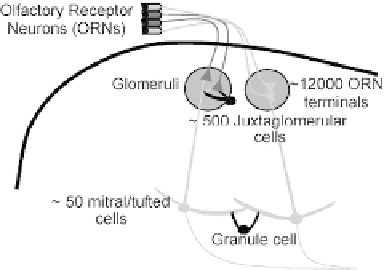Biomedical Engineering Reference
In-Depth Information
Fig. 4.1. Synaptic organization of the olfactory bulb. Terminals from ORNs expressing
different odorant receptors converge into different glomeruli.
(ii) The glomerular synaptic connectivity is rather well known
with about 12,000 ORN terminals converging and releasing glu-
tamate onto
50 output
(mitral/tufted) cells. It should be thus possible to quantify pre-
cisely the relationship between changes in glomerular CBF and
mitral cell output. (iii) The glomerular module offers the possi-
bility to record simultaneously blood flow and neuronal activity at
the cellular level by using two-photon laser scanning microscopy.
∼
500 juxtaglomerular cells and only
∼
3. Two-Photon
Laser Scanning
Microscopy
(TPLSM),
Strengths and
Limitations
It took less than a decade between the demonstration of two-
photon excitation
(43)
and its first application to record neuronal
activity
(44)
and blood flow
(45)
in vivo. We first used TPLSM
to analyze mitral cell responses to odor in the anesthetized rat.
We could demonstrate that several types of calcium signals were
evoked by odor, involving the resting membrane potential, post-
synaptic potentials and backpropagating spikes
(46, 47)
.Simul-
taneously, we investigated which optical and biological parame-
ters limit TPLSM in depth. Because the principle of TPLSM has
been reviewed several times, we will just mention several technical
points important to keep in mind when imaging in depth using
standard optics (without using gradient refractive index lenses)
(48, 49)
or optical fibers
(50, 51)
. Light scattering limits both
the incident infrared light and the collected fluorescent light, the
number of ballistic (unscattered) photons diminishing in an expo-
nential fashion with the thickness of brain tissue. This has obvious
implications for in vivo imaging
(52)
:
3.1. Incident Light
The incident light scattering length increases with the wave
length. As a result, in order to improve imaging in depth, it may
be worthwhile to excite a chromophore at the longest wavelength

